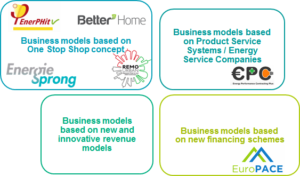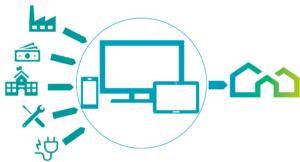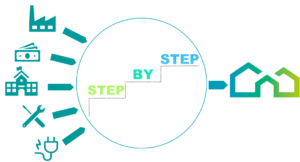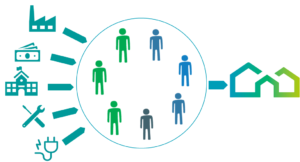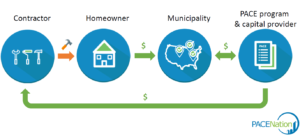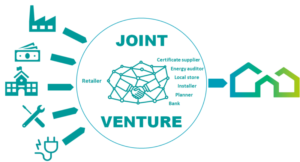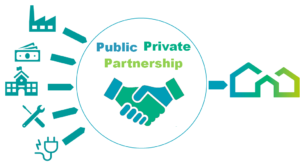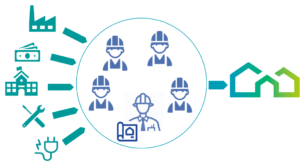My profile
The objective of this section of the Renovation Hub is to present the variety of Business Models that already exist to support energy renovation, guide you in this large collection to find the best “recipe”, provide recommendations for replication, and illustrate the application of most promising ones through Cases Studies.
We have identified four main families of business models:
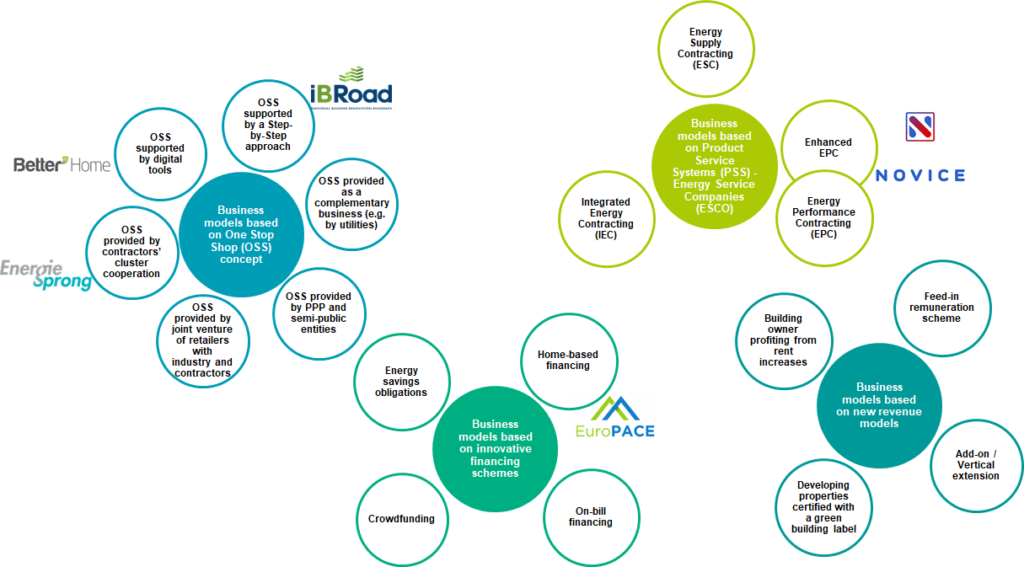
Real business models are often a combination of several business model patterns, and business model families should not be considered in isolation: on the contrary, combining several patterns can provide a more robust business model.
When setting up a renovation project, the chosen business model(s) should be tailored to the targeted market segment:
| For who? | The problem |
What? (Recommended Business Model) |
How? |
Can be combined with: | Where? (Example of countries with high potential for this BM) | |
| Type of dwelling | Type of owner | |||||
 |
Owner occupant | Renovation journey too costly and complex for the home owner | One Stop Shop | Provided by PPP / semi-public entities | Countries with incentives for home owners to renovate | |
| Supported by a digital tool | Denmark, Germany | |||||
 |
Social housing | Renovation in occupied dwellings. Acceptance by tenants | One-Stop-Shop “Energiesprong” | Initiated by a dedicated marketing team | Add-on business model | Netherland, Denmark, Germany, UK |
| Energy Performance Contracting | Provided by an ESCO | Collective Self Consumption | France, Denmark | |||
 |
Condominiums | Renovation in occupied dwellings. Acceptance by multiple owners. | One Stop Shop | Provided by semi-public entities | Step by Step approach | Germany, France, Denmark |
 |
Public buildings | Upfront investment. Long term estate management | Energy Performance Contracting | Provided by an ESCO | Crowdfunding (for cultural heritage) | France, Denmark |
 |
Offices and other tertiary buildings | Attractivity of estates for companies / lessees | Energy Performance Contracting | Provided by an ESCO | France, Denmark | |
Other types of Business Models you may be interested in:
Other One-Stop-Shops
- OSS provided as a complementary business (e.g. by utilities, insurances)
- OSS provided by joint venture of retailers with industry and contractors
- OSS provided by SME contractors’ cluster cooperation
- OSS with home-based financing
Energy as a service:
New and innovative revenue models
New financing schemes
Each Business Model presentation is structured in four blocks: What? Who? How? Why?
In this business model the key player is supported by digital tools guiding home-owners as well as designers (or contractors) in the initial planning of the renovation work. The tool usually acts as a guide to optimize the application of the overall retrofitting process by for example collecting all the information related to the initial state of the building to be renovated and the preferences, the needs and desiderata of the building owner. The ICT tool processes the information gathered and suggests an optimised approach to the renovation project.
The main advantage is the possibility to effectively manage the whole process in a comprehensive way. As the idea is very much based on creation and availability of process descriptions, checklists and tools, the maintenance and update of the material are key. It is also highly important to be able to create reliable initial information about the building stock and provide robust initial model. In order to make reliable assessment about the saving potentials in terms of energy and costs, the actors involved must be able to use appropriately the tools for energy performance assessment and be able to make justified conclusions about the savings. Here the quality of the initial information is highly important. In addition, a solid understanding of the users’ behaviour and willingness to commit to energy savings is essential.
An example of this business model is BetterHome in Denmark, an industry-driven one-stop-shop model, which has proven successful in boosting demand for holistic energy renovations in Denmark, since the model was launched in 2014. It was profitable after just three years, with 200 projects in 2016 and is expected to continue its growth. Understanding that renovating a building is a big commitment, this model creates a burden-free experience for the building owner and offers a service that goes beyond replacing building components. The home-owner-centric renovation journey has two main mechanisms: structuring the process for the installers and increasing building owners’ awareness.
Recommendations for replication
While the central aspects of the renovation journey are replicable on most European markets, the model must be adapted to the local context. Applying a similar model in other countries will require a greater focus on quality assurance and an integration of financial support into the model. In Denmark, quality assurance is heavily regulated, including guarantees for the building owners. A more comprehensive quality and compliance scheme is required on most of the other European markets. Furthermore, the available financial subsidy scheme for energy renovations in Denmark is modest and rarely decisive for the building owners’ decision to invest. In countries with substantial public support schemes for energy renovations, this can be incorporated into the business model.
Key factors for replication are:
- Use digital solutions to bring added value to the end-users: BetterHome shows that digital solutions can help the construction industry become more consumer-centric and service oriented. Moreover, with the use of innovative digital tools, building professionals can provide a smoother process, for themselves and for the building owner. Aligning with existing stakeholders on the market, including banks and mortgage providers, creates a constructive win-win situation.
- Structure the supply-side: The success of the home-owner-centric business model can be explained by the advanced service-oriented role of the installers. BetterHome trains and guides the installers on how to approach the home-owner, from the first contact to the finalisation of the process. In support, BetterHome also simplifies and structures the renovation process for the installer, through supportive and innovative digital tools, enabling a better evolution for all involved.
- Build awareness for the end-users: Training the installers in order to sell the broader picture, including benefits (e.g. low interest rates, increase in property value, improvements to health of their children and comfort, as well as climate and environmental benefits). The installer is not just replacing the old building elements, but creating a better living environment.
- Safeguard the good reputation: In Denmark, the four companies behind BetterHome are highly respected and associated with quality. Through the cooperation in BetterHome, the companies have worked together to also raise the reputation of the installers.
The Step-by-Step renovation model is a widely diffused model of building refurbishment that consists in the replacement of different building components (such as windows, plasterwork, roof covering, boiler etc.) according to their life duration.

One of the benefits of such an approach is that it gets the most out of each building component so that the initial investment is taken advantage of to its fullest. The need for replacements of various components arises at different points in time which means that in the case of a complete building retrofit, components that are still intact are renewed unnecessarily before their due time, leading to sub-optimal investments. With the step-by-step approach this can be avoided. When applying this approach, a building renovation plan should be made for all measures, including those which lie in the distant future, before starting the work. In this way, it can be ensured that an optimal end result is achieved in terms of cost-effectiveness, energy efficiency and quality.
Recommendations for replication
The step-by-step approach is probably the most likely to be replicated as it minimises the main obstacle to the process of energy renovation of buildings, i.e. the high initial investment. It is the approach that is most suitable for small investors with a prudent attitude, who aim to improve their living conditions and who do not immediately seek a significant increase in property value.
The main advantage lies in the possibility to check, after each intervention, the benefits in terms of comfort and energy savings, splitting the risk between smaller investments, as well as keeping the possibility to make corrections in the course of future interventions.
The important elements for the success of this business model are:
- Technical know-how of the OSS consultants who advise clients:The interventions carried out in the early stages will have to be compatible with the interventions planned in the future, possibly avoiding unnecessary redundancies, and therefore the allocation of costs in interventions that will not generate savings.
- High percentage of dwellings occupied by owners: Statistically, homeowners are more likely to carry out improvement works.
- Cumulation of incentives over time: In order not to decrease the interventions after the first one, it is essential that the incentives accrued during the various interventions are compatible and cumulative.
- Acceptable level of income and possibility to take advantage of incentives provided as tax deduction: As highlighted by Ameli & Brandt, 2015 the level of income is one of the parameters most closely related to the probability of investing in energy efficiency. Obviously, it has to be weighed against the cost of living, energy and, above all, the average cost of investment.
In this model the project is carried out by a multi-disciplinary team in a cooperative manner, consisting of partners with complementary competences, such as architects and designers, constructors, energy-efficiency experts, market and financial experts, technology suppliers, strategy and operations planners. Starting from the initial design phase, the team works together, in strict collaboration with the building owner, in order to select the optimal renovation measures to adopt, planning the whole renovation project according to customers’ needs.
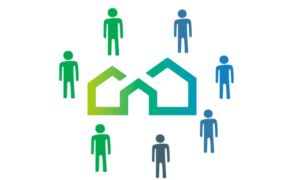
The cross-fertilisation of gathering different actors together in an early phase of the renovation project permits to define a holistic approach to the renovation intervention. In this way sustainable and energy–efficient retrofitting solutions can be deployed, with an optimal control over the total costs of the renovation project and guaranteed efficiency performances.
A successful example of this business model is Energiesprong. Energiesprong is a whole house refurbishment and new built standard and funding approach. It originated in the Netherlands as a government-funded innovation programme and has set a new standard in this market. It is now being replicated in the UK, France, Germany and Italy.
Recommendations for replication
The key to success for the replicability of this business model is the identification of the market segment to focus on.
Building upon the lessons learnt from the Hem and Nottingham case studies, the important elements in order to ensure the success of this business model in the residential sector are:
- A wide availability of similar single or multi-family buildings, characterized by not overly complex geometries, that are in need of refurbishment.
- Limited segmentation of the building stock in order to be able to deliver standardized solutions
- A stable upward trend in real estate market prices that can drive this type of investment.
- High GDP per capita and low private debt, ensuring the existence of a demand segment capable of dealing with major investments and/or high disposable income in households, or to make it financially sustainable for private individuals to purchase refurbished apartments.
- Grants and tax incentives that can support this approach in areas with lower incomes.
This business models took inspiration from the Property Assessed Clean Energy (PACE) concept, widely piloted in the US, where local governments issue bonds for renovation projects.
The building owner repays the loan through an additional special “assessment” payment on its property tax bill for a specified term. These “assessments” are comparable to loans as the property owner pays off its debt in instalments over a period of various years but from a legal point of view they are not considered as such.
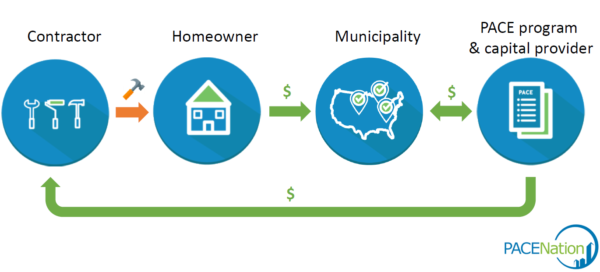
When the property changes ownership, the remaining debt is transferred with the property to the new owner. In other words, PACE financing is a mechanism set up by a municipal government by which property owners finance energy efficiency and renewable energy measures via an additional tax on their property. The property owners repay the “assessment” over a period of 15 to 20 years through an increase in their property tax bills. In the US, property tax payments are made annually or in arrears but payment modalities may be different in other countries, especially in Europe.
The PACE concept is being adapted to Europe by the EUROPACE project. As in PACE, the innovative character of the EUROPACE mechanism is that financing is linked to the taxes paid on a property. In other words, the financing lent by a private investor is repaid through property taxes and other charges related to the buildings. The EUROPACE mechanism also sets up of One Stop Shop by engaging several stakeholders in the process: local government, investors, equipment installers, and homeowners.
Recommendations for replication
In the framework of the EUROPACE Project an in-depth analysis to assess the legal and fiscal readiness for the adoption of an on-tax financing mechanism across EU28 was developed. The main key factors are hereby reported.
The important elements for the success of this business model are:
- Suitability of the legal framework for on-tax financing: As EUROPACE is added to property taxes, the suitability of the legal framework is important an important factor to consider to assess the on-tax financing mechanism replicability. Property taxes differ in many aspects between countries but issues such as the existence of a property-related tax, the regular collection of property taxes, or a relatively low level of exceptions in the tax collection mechanism are essential for the legal implementation of this business model.
- Municipal capacity to develop an on-tax financing mechanism and municipalities’ experience and policy objectives concerning EE and/or climate mitigation: Municipalities play a vital role in the EUROPACE business model, as they have an interest in implementing EE solutions and are also relevant actors in the creation of private-public partnerships (PPPs). The experience of municipalities in working on comparable assignments and to estimate their readiness to implement EUROPACE, can be assessed referring mainly to municipalities’ capacities to manage EE projects, particularly in a PPP model. According to the best practices from PACE implementation in the US, a key indicator for replicability is a case where the municipality has experience working with the private sector to implement broadly defined investment programmes. Another key indicator for replicability is the existence of EE programmes and policies in buildings
- >Enforceability of local taxes and/or property taxes and assessment of charges, defaults, and delinquencies: The enforceability of local taxes and/or property taxes and an assessment of charges, defaults, and delinquencies assesses as well the roles and responsibilities of the local authorities that provide guarantees (including senior liens) to investors. In particular, this replicability indicator focuses on the progress made towards fair, standardised, and transparent administrative processes as well as possible penalties, tax liens, and, eventually, foreclosure procedures in cases of the non-payment of taxes. A fully developed guarantee mechanism over the payment of property taxes is considered as a key enabler.
- Political, institutional, and social perceptions and acceptance of EUROPACE: It is difficult to compare the attitude towards property taxes, as these vary significantly among the countries analysed. There is a vast set of secondary country-specific data on the impact local taxes have on elections and on local and national debate in general. While in some countries politicians barely mention the importance of local taxes, in other, increases in local taxes lead to mass protests and can determine the results of local (or central, if the government is fully in charge of local taxation) elections. In principle, it can be concluded that the more stable and institutionally continuous the tax is, the easier it will be to use it as a basis for EUROPACE implementation.
The One-Stop-Shop concept means that a single service provider is responsible for holistic renovation of the building as per the wishes of the building owners, including implementation of energy efficiency measures, or building internal renovation. Thus, the one-stop-shop model foresees that a single actor offers full-service holistic renovation packages including consulting, independent energy audit, renovation work, follow-up (independent quality control and commissioning) and financing.
Key actors that could develop a One-Stop-Shop Model for the renovation of existing buildings are real estate agencies, insurance companies and utilities. These key actors take advantage of their existing market position, to sell a complete package which they compose by using subcontractors to gather the right skills. The advantages and opportunities offered by the development of such a complete service package are:
- To enter a growing market (energy efficient renovation)
- To open new businesses thanks to the development of new partnerships with other companies
- To offer a clear and complete value proposition (and quotation) that fulfils the needs of the owner.
The first step to develop a new and innovative One-Stop-Shop business model is to understand the customers’ real needs. Regarding renovation, the building owner might not know precisely his own needs, as he may have limited knowledge about what can be done to the building in order to make it more energy efficient. The decision-making process is therefore a “learning process”. To guide him through this, credibility and trustworthiness is a prerequisite. As a consequence, the challenge is to create consortiums with a mixture of credibility, an existing market position, capacity and capability to supply a complete package of good quality. In the case of stakeholders that decided to expand their business into renovation as a complementary business, they shall involve directly the different trades (e.g. installers to change the heating system, carpenter to install windows, construction company to improve insulation and/or install windows, energy auditor to evaluate energy efficiency potential, and if relevant window/door supplier, insulation supplier, painters, heating system suppliers).
Public Private Partnerships (PPP) are a well-known delivery model in the construction sector, involving a contract between a public sector authority, the building owner, and a private contractor in charge of the management and the development of the building renovation project. The private party provides the service to the public authority, assuming substantial financial, technical and operational risks in the renovation project. This model is already widely used around the world, on a project basis, i.e. a new PPP is usually settled for each building (or set of buildings) to be renovated.
The Energy Performance Contracts (EPCs) where the public sector uses private energy service companies (ESCO) through Public Private Partnership arrangements, fits for instance in this category (more information can be found under the EPC description).
In this collaborative model, private and public partners collaborate coordinating their skills and knowledge for long term contracts (usually 20-30 years). The selected contractor involves designers, maintenance services providers and other subcontractors needed stipulating specific contracts with each of them, during the whole project duration, being the only contact point for the public building owner.
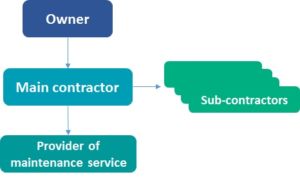 PPP models are mostly used in very complex projects that require high level of integration. Since PPP delivery method is widely used around the world, many types of financing contracts may be used under this scheme: usually, for instance, the PPP contractor finances the initial investment and the client pays a constant fee for using the property during the contract. In some cases, a private sector consortium may create a special company called a “special purpose vehicle” (SPV) to develop, build, maintain and operate the asset for the contracted period.
PPP models are mostly used in very complex projects that require high level of integration. Since PPP delivery method is widely used around the world, many types of financing contracts may be used under this scheme: usually, for instance, the PPP contractor finances the initial investment and the client pays a constant fee for using the property during the contract. In some cases, a private sector consortium may create a special company called a “special purpose vehicle” (SPV) to develop, build, maintain and operate the asset for the contracted period.
PPP model are usually implemented in the case of multidisciplinary projects where team members have to strongly collaborate. Because of the mix of responsibilities and finance schemes, PPP delivery models provide opportunities for both public and private sector. However, PPP are complicated delivery models in the construction sector that require strong involvement of the different stakeholders, therefore PPP delivery method may cause an increase in time and cost of projects delivery and increase potential risks associated to the different steps of development.
In today’s construction industry a movement from conventional competition and contract models towards new partnership and collaborative business models can be observed. These partnership business models comprise management and manufacturing methods and correspond more to real businesses in the construction industry. This progress of the market within the construction sector leads to a usage of new business models also in order to overcome traditional price-driven competition towards a more collaborative working environment and a value-driven competition. Moreover, each large building retrofitting project needs slightly different business models according to building ownership, building typology, scope of the retrofitting, requirements, barriers such as available financing, actors engaged, guarantees, referenced projects, etc. The actors in the retrofitting project life cycle should be able to choose the optimal business model, and should be able to realise it (organisation, contracts, resources, knowledge, and technical competences). Solid and well-defined methodology and digital tools are needed for the project based on development and implementation of these novel business models. An individual SME is limited in many ways to reach these goals. The only solution is a collaborative, cluster or networked based approach.
In this context, it may happen that the service provider of the One-Stop-Shop business model is a team of contractors that may all be SMEs or with a major contractor and its affiliated partners. Small-medium sized construction companies may thus enter into partnerships with other actors such as suppliers of key components/material and architect/engineering company if these capabilities do not exist in house.
In case of SME cluster collaboration, generally, the SMEs scope, competences and resources are limited for developing large construction investments, for example large real-estate retrofitting projects. Mainly in the public sector, where the competition is based on the “lowest price” criterion, the SMEs have many difficulties to win the projects. An important opportunity is the adaptability and flexibility of SMEs to different contractual arrangements. This can be implemented only by a group of companies covering all required competences, in well-organised collaborative approach. The operation and maintenance organisation and end-users should be directly involved. These actors have key impact on high performing buildings (retrofitted buildings) and with that also on the overall outcome (economic, environmental, social) of the retrofitting project.
In this framework, SMEs operating in the construction field and in the same region may look for a holistic coverage of the construction industry market, applying business models which can be profitable by fulfilling a wide spectrum of clients’ requirements. Clusters of regionally active construction SMEs have an increasingly need to be organised into networks or strategic alliances. This will answer to the business opportunities, which require individual resources such as specific expertise, workforce or equipment. For widening the range of competences some of them enter even wider association such as e.g. German Facility Management Association (GEFMA).
Nevertheless it has to be underlined that when the client is from the public sector, it is necessary to define the leader of the SME cluster to be possible to contract projects. Definition of the leading SME partner can be a problem. Legal issues have to be cared about (contract forms, assurances in the case of SME bankruptcy, responsibilities and guarantees for longer time).
The EPC model is based on delivering energy savings compared to a predefined baseline. In this model, an Energy Service Company (ESCO) enters into arrangements with property-owners to improve energy efficiency of their property by implementing various measures. The ESCO guarantees energy cost savings in comparison to a historical (or calculated) energy cost baseline. For its services and the savings guarantee, the ESCO receives performance-based remuneration in relation to the savings it achieves. Generally, savings achieved can only be measured indirectly as difference between consumption before and after implementation of the energy efficiency (EE) and renewable energy (RE) measures (relative measurement: savings = baseline – ex post-consumption).
Most EPC projects focus on the implementation of energy efficiency measures (lighting, HVAC, energy management and control, envelope insulation). EPC models run under long-term contracts of typically ten years, depending on the payback time of the energy savings measures and the specification of the building owner (i.e. they may last up to 15 years when they include long payback-period investments such as wall insulation or window replacements).
Recommendations for replication
The main advantage of this Business Model is that it overcomes the main obstacle that limits energy refurbishments in case of multi-family buildings, namely the high initial investment costs.
In light of the business cases analyzed, the important elements in order to ensure the success of this business model in the residential sector are:
- Presence of regulations encouraging, if not even imposing, the heat metering in condominiums with centralized systems.
- High energy consumption and costs: Several sources state that EPC provided by ‘traditional’ ESCOs are only suitable for large projects (with a minimum energy cost baseline of around 200,000€/year). This requires clustering several multi-apartment buildings to achieve a significant number of dwellings. However alternative models, developed by smaller players, can be developed for single house or small condominiums.
- High share of occupant-owner (or one single owner, as in the case of social housing)
- Regulatory flexibility, allowing the application of the mechanism also in the case of tenant occupied apartments
- Presence of incentives, in the form of subsidies, even if the investments are borne by ESCOs.
- Low interest rates
- Access to third party financing (TPF) for small ESCOS: Small ESCOs (SMES) could open the EPC offer to single houses and small condominiums. However borrowing for ESCOs requires a credit history, which hinders the access of SMEs and small structures to finance. Facilitating the access of small ESCOs to TPF would alleviate this barrier.

